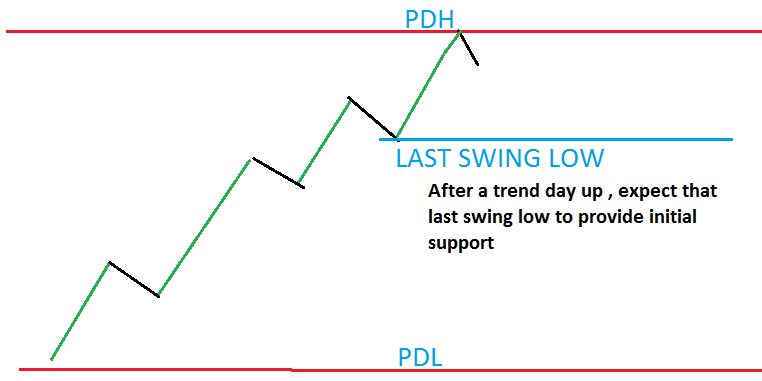Intraday Trading Course
This is the first part of the Intraday Trading Course for Beginners as well as Professional Traders. I strongly recommended you to follow this and our upcoming articles to gain more knowledge about Intraday Trading. Here, in this article, you will learn, how to prepare for day trading before the market open. These are the factors, we should study
- Index
- Context
- Previous day activity
- Next support and resistance
- Area of opportunity
- Possible entry price action
- Index (if you trade in index stock)
1. Context
Where price is with respect to the major trend
- Up/down/range(trend)
- Pullback /impulse swing
2. Previous day activity
Price what did last day?
Studying the previous day’s profiles to get clues for today is one of the essential steps a trader has to perform daily. When a trader starts tracking this regularly when it becomes a habit, he will always be in sync with the Short Term moves in the markets. We will study the following parameters to understand the previous day
- Attempted Direction (Up, Dn, Sideways)
- Volume Generated (High, Low, Unchanged)
- Position of Close (STRONG/WEEK/neutral)
- Last swing high/last swing low
By studying the above factors we can get a tight grip on what the SM was trying to achieve the previous day and was that attempt successful. And Possible the trend for next day
LAST HIGH AND LOW
If the previous day has had a trending day in which price was marked up to a new level, the previous day’s high or low will not be as important. For example, in the case of a trend day UP, the previous day’s low is not likely to test. Instead, the last swing low becomes the important support level. This support level is most important in the morning session of trading. After a trend day up, expect that last swing low to provide initial support

Position of close
- If the market strong closes(either near to the previous day high or near to the previous day low), it is giving the trader a very loud and clear signal that continuation is likely the next day.
- The last hour often tells the truth about how strong a trend truly is. Smart money or strong hand shows their hand in the last hour, continuing to mark positions in their favor
- Neutral CLOSE MEANS. Price close middle of the day. The previous day was a range day. If neutral closing in previous day we expect the price will reverse from either previous day low or previous day high in next day. If the trend up then we expect the price will reverse from the previous day low


Volume and attempted direction
- High volume on the closing hours indicates continuation the next morning in the direction of the last half-hour.
- If the market makes a trending move in the last hour after a lifeless opening session, be positioned in the direction of that move by the close. There are very high odds of an opening gap in your favor the next morning.
3. Next support and resistance level
- Where are immediate support and resistance or supply and demand zone
- This is decided our risk to reward
4. DEFINING AREA OF OPPORTUNITY
Trading is all about Location. Define a location where a decisive group of traders acts and fight it out is the key. Wait for the market to hit the identified price level, watch which side takes control, buyers or sellers. Go with the winning team and enter where the losers start exiting and allow their order flow to take our position to profit. Location for the area of opportunity is
- Previous day High, previous day Low
- Last swing high and last swing low
- Major Swing Pivots.
- Big Round Numbers
The previous days high and low are two very important “pivot” points, because where buyers or sellers came in the day before. Look for price action at these points for either continuation or reversal. These are markets own levels and the market is going to respect its own levels.
5. INDEX AND SECTOR
First Identify the support (demand) and resistance (supply) levels in the NF and any sector. If markets closed near demand, I would know to look for opportunities to buy the next day as the price was likely to rally from that demand level
The next step was to look at charts of a few of the large sectors to find some that are also trading near demand as those sectors would likely rally from that demand level with the broad (NF and BNF) market the following day. Out of the few sectors, I would always find one or two that were set up very well with the broad market.
The final step was to look at a handful of high volume stocks within that sector and that is always where I would find a VERY quality trading opportunity
6. ENTRY PRICE ACTION
There are three price action trade setups when price encounters an area of opportunity.
- Breakout failure
- Breakout pullback
- Test Reversal

Trading these three price action patterns blindly is a recipe for disaster. There are other factors to be considered while trading these price action setups like Strength of Trend, volume, price action, etc.
Please watch the following video if you want to learn and understand this concept in a better way.




Tiada ulasan:
Catat Ulasan